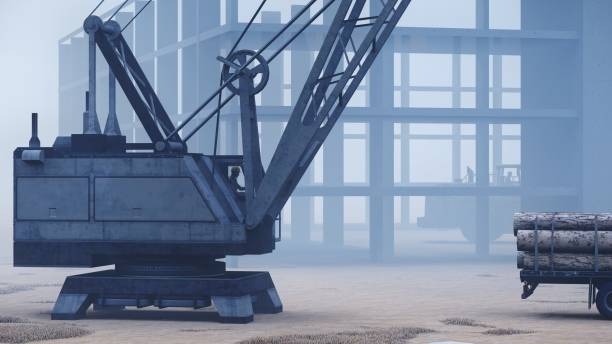Construction projects, whether for towering skyscrapers or expansive bridges, all involve complex logistical challenges. In the modern era of construction, efficiency and reliability are of utmost importance, not least when it comes to the heavy lifting involved. One piece of equipment that has become indispensable in such endeavours is the crawler crane. Possessing exceptional capabilities, crawler cranes play a critical role in the construction industry today.
Introduction to Crawler Cranes
Crawler cranes are a type of mobile crane that is mounted on an undercarriage with a set of tracks (also known as crawlers) that provide stability and mobility. These heavy-duty machines are built to lift, lower, and move substantial loads over a construction site, making them vital for large-scale industrial and construction projects.
Enhanced Stability and Lifting Capacity
One of the primary advantages of using a crawler crane is its stability. The wide base provided by the tracks ensures a secure foundation, allowing these cranes to lift weights that would be impractical or even impossible for other types of cranes. Furthermore, the tracks allow for better weight distribution across the ground, reducing the risk of sinking on soft soil and enabling operation in varied terrain.
Optimal for Long-term Projects
Crawler cranes are ideal for extended construction projects due to their durability and low ground pressure. These cranes can be situated on a construction site for long periods without requiring frequent relocation. This makes them particularly suitable for projects such as the construction of wind farms, petrochemical plants, and large building complexes.
Improved Mobility Over Rough Terrain
Another significant attribute of the crawler crane is its capability to manoeuvre over uneven and rugged terrain. Unlike wheel-mounted cranes, crawler cranes can traverse sites that are uneven, muddy, or loose underfoot, which is often the case in off-road construction environments.
Key Components and Features of Crawler Cranes
A typical crawler crane comprises several critical components, including a boom, counterweights, and the undercarriage, which includes the crawlers themselves. The boom can vary in length, with some crawler cranes featuring telescopic booms that can be extended as required, while others have lattice booms that are assembled on site to reach the required height.
Heavy-duty Lifting in Constrained Spaces
Because of the crawler crane’s robust construction and lifting prowess, it is often deployed in situations where the space is constrained, and heavy lifting is required. For example, in urban environments or inside operational plants, the crane’s footprint and lift capability need to be perfectly balanced. Crawler cranes meet this demand exceptionally well.
Efficiency on Site
The efficiency of crawler cranes is further heightened by their relative ease of assembly and disassembly. This is an essential aspect of meeting tight construction schedules. Many crawler crane models have been designed with modular components, facilitating quicker setup times and saving on transportation costs.
Choosing the Right Crawler Crane for Your Project
Selecting the appropriate crawler crane for a particular project is crucial. The choice is influenced by several factors, including the maximal weight of the intended load, the maximum height at which the load must be lifted, the conditions of the site, and the nature and duration of the project. For instance, a project that involves lifting exceptionally heavy loads, such as bridge sections, would necessitate a crane with a greater lifting capacity.
Specialist Providers Offer Expertise and Reliability
Engaging with specialist providers is essential when sourcing crawler cranes for complex projects. These providers offer expert advice on the optimal machinery for a project, along with maintenance, support, and training. Professional crawler crane suppliers ensure that equipment operates at peak efficiency and adheres to the strict safety standards required in the industry.
The Future of Crawler Cranes
As construction techniques advance, so does crane technology. Today’s crawler cranes are more sophisticated than ever, featuring state-of-the-art technology such as computer-aided control systems that increase precision and safety. In addition, manufacturers continuously develop designs that improve the load capabilities and efficiency of these machines.
Adapting to Green Construction Practices
The construction industry increasingly prioritises sustainability, and crawler crane manufacturers are adapting by producing more environmentally friendly models. These advancements include more fuel-efficient engines and hybrid systems that reduce the carbon footprint of construction activities.
Conclusion
The construction landscape continually changes and evolves, but the need for reliable, efficient, and powerful lifting solutions remains constant. In this respect, the crawler crane has proven to be an invaluable asset within the industry. By providing stability, mobility, and robust lifting abilities, crawler cranes not only ensure the success of construction projects but also drive innovation in how those projects are executed. Without a doubt, the role of crawler cranes in modern construction is not merely important; it is vital.
Responsiveness to Market Needs
Understanding market needs is driving change in the crawler crane segment. The emphasis on faster construction timelines and the ability to work in diverse environments drives demand for cranes that are versatile and quick to deploy. As a result, crawler crane manufacturers are constantly innovating to meet these industry demands.
Final Thoughts
Throughout the evolution of the construction industry, crawler cranes have continued to be a fundamental factor in many projects’ success. Their flexibility in function, combined with heavy-duty lifting capacity, makes them a cornerstone in the field of construction. As projects grow in complexity and scale, the modern crawler crane will undoubtedly continue to occupy a central role, paving the way for the efficient erection of future monuments of architecture and infrastructure.



